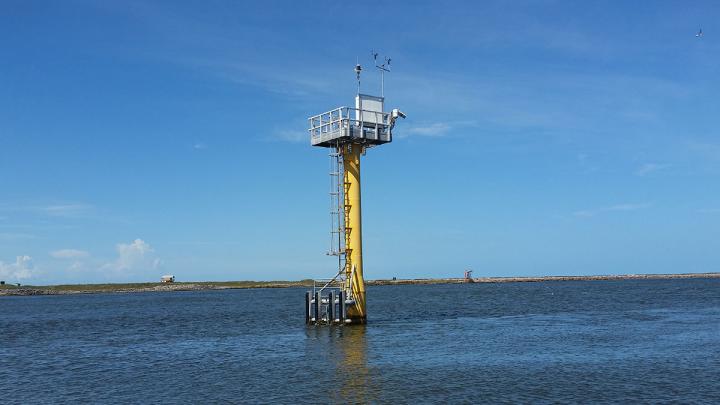Century of data shows sea-level rise shifting tides in Delaware, Chesapeake bays

A tide level gauge that has been bolstered to withstand hurricanes. Researchers have shown that sea-level rise is changing patterns of the tides in the Delaware and Chesapeake bays. Credit: NOAA
The team combined a computer model with 100 years of observations to tease out the fact that global sea-level rise is increasing the tidal range, or the distance between the high and low tides, in many areas throughout each bay.
Tides, or the rising and falling of the ocean's surface, occur on regular intervals and result from numerous factors, the biggest of which is the gravitational pull from the sun and moon. For centuries, people have documented and predicted the daily high and low tides because they can impact ocean navigation. Tides can also affect ocean life, flooding risk, fishing, the weather, and some energy sources such as hydroelectric power.
In 2015, Andrew Ross, meteorology doctoral student, Penn State, noticed an odd pattern emerging while testing a numerical computer model for tidal research. Adding one meter of sea-level rise to the model resulted in a distinct pattern of changes to the high and low tides throughout the Chesapeake Bay.
“We weren't sure why it was there, but it was unique enough that we thought it should show up in observations, too, if it was actually real,” said Ross, now a postdoctoral research associate, Princeton University. “So we started looking at the observations, doing more comparisons.”
Ross began working with a team that included his adviser, Raymond Najjar, professor of oceanography, Penn State, to pinpoint the precise effects of sea-level rise by subtracting other forces that affect changes to the tidal range. Some of these forces are predictable, including the 18.61 years it takes for the moon's orbit around the Earth to oscillate.
Other forces are less predictable, like the effect from dredging a bay to create a wider, deeper space for container ships. The team analyzed tidal gauge records from 15 locations in the Delaware and Chesapeake bays, the oldest of which dates back to 1901. They also studied nearby cities outside of each bay to control for larger changes affecting the ocean more broadly.
Once they isolated sea-level rise's influence on the tides using the tide gauge records, they compared this information with a computer model in which they could adjust the overall sea level, simulating the effects of the past or future. They reported, in the Journal of Geophysical Research: Oceans, that both the tide gauge data and the model generally agreed on the main effects of sea-level rise on tides. The analysis showed that one meter of sea-level rise increased the tidal range by up to 20 percent in some areas. The exact amount of change from sea-level rise varied based on physical characteristics such as the shape of the bay.
“In the Delaware Bay, as you go upstream toward Philadelphia, the shore lines are converging in a sort of funnel shape, and so we see that amplifies sea-level rise's effects on the tides,” said Ross. “That amplification gets magnified the farther you go upstream.”
By contrast, the shape of the Chesapeake Bay resulted in a different pattern of effects, in some cases slightly decreasing the tidal range. Compared to the Delaware Bay, the Chesapeake Bay is longer and has less of a funnel shape. After a wave enters the Chesapeake Bay from the ocean, it eventually hits the end of the bay and reflects back towards the ocean, either adding to or subtracting from the heights of waves it contacts. Because waves travel faster in deeper water, a higher sea level results in a faster wave speed. This changes where incoming and outgoing waves interact with each other, which has a cascading effect on tide patterns throughout the bay.
“When people think about flooding associated with sea-level rise, they often think everything will just go up, including the tides, but the reality is that in some cases, the tidal range may stay the same or decrease,” said Najjar. “It all depends on the geometry of the bay and the speed of waves, which we know are affected by rising sea levels.”
###
Collaborators include Ming Li, Fan Zhang, and Wei Liu, Horn Point Lab, University of Maryland, and Serena Blyth Lee, Griffith University, Australia.
The National Science Foundation supported this research.
Media Contact
All latest news from the category: Earth Sciences
Earth Sciences (also referred to as Geosciences), which deals with basic issues surrounding our planet, plays a vital role in the area of energy and raw materials supply.
Earth Sciences comprises subjects such as geology, geography, geological informatics, paleontology, mineralogy, petrography, crystallography, geophysics, geodesy, glaciology, cartography, photogrammetry, meteorology and seismology, early-warning systems, earthquake research and polar research.
Newest articles

Pinpointing hydrogen isotopes in titanium hydride nanofilms
Although it is the smallest and lightest atom, hydrogen can have a big impact by infiltrating other materials and affecting their properties, such as superconductivity and metal-insulator-transitions. Now, researchers from…

A new way of entangling light and sound
For a wide variety of emerging quantum technologies, such as secure quantum communications and quantum computing, quantum entanglement is a prerequisite. Scientists at the Max-Planck-Institute for the Science of Light…

Telescope for NASA’s Roman Mission complete, delivered to Goddard
NASA’s Nancy Grace Roman Space Telescope is one giant step closer to unlocking the mysteries of the universe. The mission has now received its final major delivery: the Optical Telescope…



